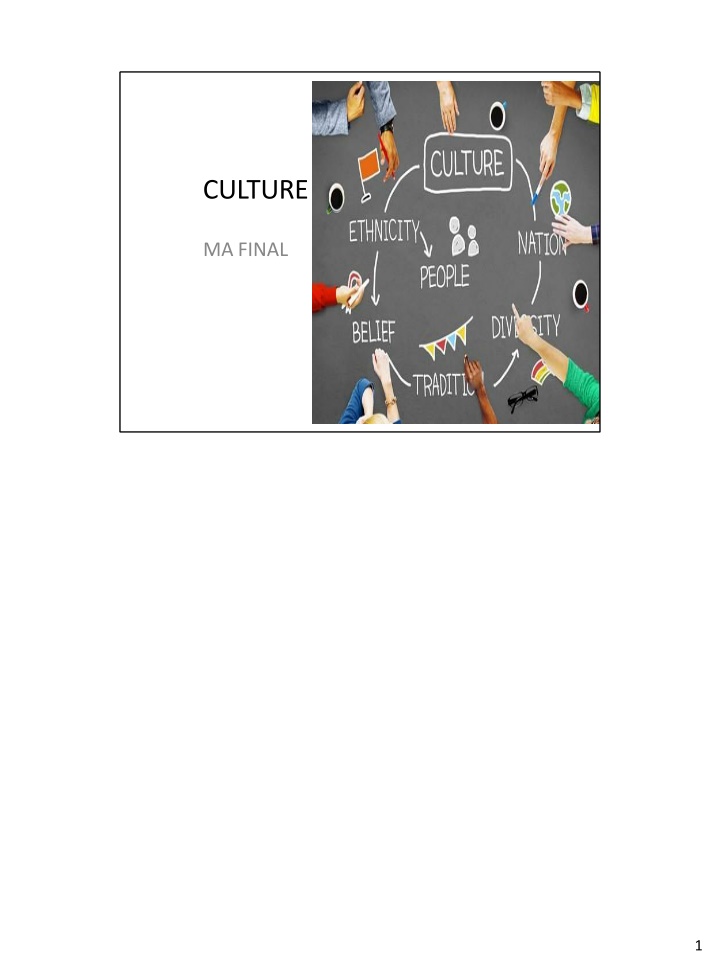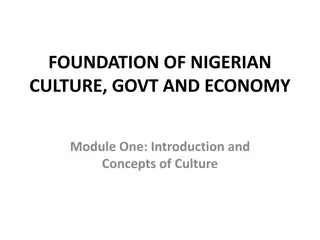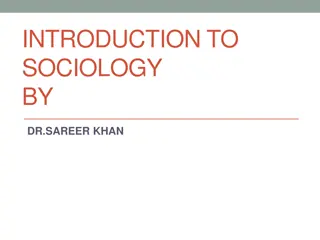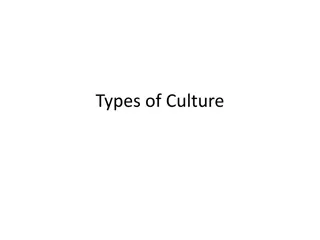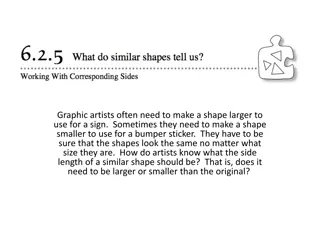Culture: How It Shapes Our Lives
Culture plays a significant role in shaping our lives, influencing what we eat, wear, listen to, and how we express emotions. Explore the impact of culture on societies worldwide, from informal norms in Bhutan to the roots of the word "culture." Dive into the complexities of defining culture, its types, and its essence in society.
Download Presentation

Please find below an Image/Link to download the presentation.
The content on the website is provided AS IS for your information and personal use only. It may not be sold, licensed, or shared on other websites without obtaining consent from the author.If you encounter any issues during the download, it is possible that the publisher has removed the file from their server.
You are allowed to download the files provided on this website for personal or commercial use, subject to the condition that they are used lawfully. All files are the property of their respective owners.
The content on the website is provided AS IS for your information and personal use only. It may not be sold, licensed, or shared on other websites without obtaining consent from the author.
E N D
Presentation Transcript
CULTURE MA FINAL 1
Culturedetermines Food we eat Clothing Music Games we play How to express emotions Whatis good or bad Whatis high or low culture (if any) 2
According to the informal norms of culture of the mountainous Asian kingdom of Bhutan, people greet each other by extending their tongues and hands 5
MEANING OF THE WORD CULTURE Theword "culture"derives from a Frenchterm, which in turn derives from the Latin "colere," which means to tend to the earth and grow, or cultivation and nurture (CristinaDe Rossi) In this sense culture is the man-made environment and the people living in a society actually growtheir wayof life over time. Western culture, European culture, Pakistani culture,Pakhtooncultureetc 7
INTRODUCTION Culture is the ways of thinking, the ways of acting, and the material objects that together form a people s way of life. Culture is NOT society-culture is a blueprint for how we live, think and act, while society is a group of people within a geographic area. Culture includes the traditions we inherit and pass on to the next generation Culture: totality of our shared language, knowledge, material objects, and behavior 8
DEFINING CULTURE Culture is that complex whole which includes knowledge, belief, arts, morals, laws, customs, and any other capabilities and habits acquired by man as a member of society. (Edward B. Taylor,1871:1) Culture is the ways of thinking, the ways of acting, and the material objects that together form a people s way of life (Macionis, 2012: 54). 9
TYPES OF CULTURE Material culture a component of culture that consists of the physical or tangible creations (such as clothing, shelter, and art) that membersof a society make, use, and share. Nonmaterialculture a component of culture that consists of the intangible human creations of society (such as attitudes, beliefs, and values) that influence people s behavior. 10
Characteristicsof Culture Culture is learnt; Culture is not inherited biologically, but learnt socially by man. It is not an inborn tendency. There is no cultural instinct as such culture is often Learned ways of behavior . Culture is social; Culture does not exist in isolation. Neither phenomenon. It is a product of society. It originates and develops interactions. It is shared by the members of society. is it an individual through social 11
Characteristicsof Culture Culture in the Culture sociological sense, is something shared. It is not something that an individual alone can possess. For traditions, beliefs, ideas, values, morals etc. are all shared by people of a group or society. is shared; example, customs, 12
Characteristicsof Culture Culture is Culture capable of being transmitted from one generation to the other. Parents pass on culture traits to their children, and they in turn to their children, and so on. Culture is transmitted not through genes but by means of language. Language is the main vehicle of culture. is transmissive; 13
Characteristicsof Culture Culture Though culture is relatively stable it is not altogether static. It is subjected to slow but constant changes. Culture is responsive to the changing conditions of the physical world as it assists us to survive and adapt to the changes. is dynamic and adaptive; 14
CharacteristicsofCulture Culture society; Every society has a culture of its own. It differs from society to society. Culture of every society is unique to itself. Cultures are not uniform. varies from society to 15
Components of Culture Values Norms Symbols Language 16
Components of culture 1. Values Collective concept of what is good, bad , desirable, proper ,and improper that serve as broad guidelines for social living. Values indicate what people find important and morally right (or wrong) Respect for parents, elders Cleanliness Generosity Values are broad principles that support beliefs. Beliefs are specific thoughts or ideas that people hold to be true. and Ten Core Values identified byRobin M. Williams, Jr.in the 1970 s Individualism (ability, work ethic, responsibility) Achievement andSuccess (do betterin life) Activityand Work ( work in play, active lifestyle) Science andTechnology (expectations from ) Progress andComfort (goods, services, andnecessities) Efficiency and Practicality (bigger,better,faster things) Equality (class equality andopportunity) Morality andHumanitarianism (aiding others in need) Freedom andLiberty (self explanatory) Racism and Superiority (value group aboveothers) 17
Components of Culture 2. Norms; rules developed by a group of people that specify how people must, should, may, should not and must not behave in various situations. These are rules and expectations by which a society guides the behavior of its members. 18
Components of Culture There are two aspects of norms PROSCRIPTIVE should not and must not ; prohibited Laws that prohibit us from driving over the speed limit PRESCRIPTIVE must, should, may ;prescribed like medicine Persons making a certain amount of money are expected to file a tax return and pay any taxes they owe. 19
Components of Culture a)Folkways are informal norms or everyday customs that may be violated without serious consequences within a particular culture. norms of routine or casual interaction (ex. Shaking hands, eating styles, saying excuse me) 20
Components of Culture b) Mores (pronounced MOR-ays) Mores norms that are widely observed and have great moral significance*. Often breaking norms lead to being outcast or imprisonment (ex. Incest, rape, murder) are strict norms that control moral and ethical behavior. Laws* are formal, standardized norms that have been enacted by legislatures and are enforced by formal sanctions. Because mores are based on cultural values andare considered to be crucial to the well-being of the group, violators are subject to more severenegativesanctions/punishments (such as ridicule, loss of employment, orimprisonment) Lawsmay be Law- Written codes thatcontrol the behaviour of people; Laws may be eithercivil or criminal. Civil law deals withdisputes among persons or groupswhile Criminal law deals withpublic safetyandwellbeing. 21
Components of Culture #Taboos are mores specifying what actions are prohibited in a culture. Taboos are mores so strong that their violation is considered to be extremely offensive and even unmentionable. Taboo meaning a culture absolutely forbids them. Eating human flesh - cannibalism Incest Taboos forMuslims: Eating pork Gambling Consumptionof Alcohol/ intoxicants 22
Components of Culture 3. Symbols: A symbol is an object, word, or stands for else. Symbol is anything that carries a meaning recognized people who culture (a flag, a word, a flashing red light, a raised fist, an animal etc). action something that particular Pakistani color represents Islam and the Muslim Pakistan and stripe represents minorities. In the center, the crescent symbolize light respectively. flag:The green by a share majority the in white the and star and progress 23
Symbols help us communicate ideas. A siren is a symbol that denotes an emergency situation and sends the message to clear the way immediately. Symbols mean different people, which is why hypothesize how a specific culture will symbolize something. In European culture the color black has come to symbolize death and is worn at funerals. In other cultures, Asian for example, white often symbolizes death and is worn at funerals. things is to different it impossible to 24
Non-verbal gestures can be very symbolic anddiverse. In Argentina, rotating one s index finger aroundthe front of the ear means You have a telephonecall, but in the United States it usually suggests that a person is crazy (Axtell, 1991). Similarly, making a circle with your thumb and index fi nger indicates OK in the United States, but in Tunisia it means I ll kill you! (Samovar and Porter, 1991). 25
1. Peace Symbol: A Dove 2. Peace Symbol: anti-nuclearemblem 3. HealthCare 4. A nazar is an eye-shapedamulet, Turkish believes thatit protects against the evil eye. 26
4. Language: Culture is the social heritage of the humans that is transmitted to the future generation mainly through language. Language is a system of words and symbols used to communicate with other people. Language is a set of symbols that expresses ideas and enables people to think and communicate with one another. Verbal (spoken) language and nonverbal (written or gestured) Language help us describe reality. 27
High Culture and PopularCulture: High Culture is the pattern of cultural experiences and attitudes that exist in the highest class segments of a society. People often associate high culture with political power, wealth, prestige and aesthetic taste. E.g: attending a live musical programme,joining golf club etc. Events/ way of life in highculture can be expensive andformal. 28
PopularCulture refers to the pattern of cultural experiences and attitudes that exist in mainstream society. Unlike highculture, popular culture is known and accessible to most people. 29
Cultural Relativism;the belief that the behaviors and customs of any culture must be viewed and analyzed by the culture s own standards. One cannot judge anyone else or another culture as these standards vary according to culture, time and situation. No practice is universally good or bad, goodness and badnessare relative not absolute. We should not judgeothercultures beliefs andbehaviors until we havea thorough understandingof why theyact andbelieve as theydo, based on a clear understandingof theirhistory, religion, technology, and environmental situations. 30
Ethnocentrism; the tendency to judge other cultures according to the norms and values of our own culture. Ethnocentrism is based on the assumption that one s own way of life is superior to all others. 31
Culture and Related Concepts IDEALVSREAL CULTURE: There is sometimes a gap between cultural guidelines (values) and actualbehaviour.This gap exists at a bigger level between ideal culture and realculture. Ideal culture includes the values and norms that a culture claims to have.It involves an idealized, uncompromising value system that dictates perfect behavior. Ideal values are absolute; they bear no exceptions. Using ideal culture as a standard, you are either right or wrong. 32
Culture and Related Concepts Real culture can be observed in our social life. Real cultureshowshow individuals actually live and act. Example: It is commonly imagined or claimed that the our joint family system is providing care and respect to the elderly parents (ideal culture), but in reality many have moved away from their parental homes leaving their elderly parents alone ( real culture) 33
Culture and Related Concepts SUBCULTURE: A subculture is a category of people who share distinguishing beliefs, values, and/or norms that set them apart in some significant manner from the dominant culture. It shares in overall culture of the society but also maintain a distinctive set of values, norms, lifestyles, traditions distinct language*. Sub culture may reflect a social and ethnic difference. and even a * Subculture differs from dominant culture but not in opposition to thatculture. a smaller cultural group within a larger culture Examples: 1. Based on ethnicity: Pakhtoon, Pujabi, Sindhi, Balochi culture ( subcultures) within Pakistani culture(dominant) 2. Sometimes based on religion: 34
COUNTERCULTURE: Some subcultures actively oppose the larger society. Subculture is a group whose values, beliefs, and lifestyle conflict with those of the dominant culture. A counterculture is a group that strongly rejects dominant societal values and norms and seeks alternative lifestyles (Yinger, 1960, 1982). Examples: Mafia involved in drug trafficking, Drug abusers and addicts Basically, countercultures exist withthe purpose of changing dominant culture. 35
Culture and Related Concepts CULTURAL LAG ; the term was coinedby WilliamF. Ogburn, an American sociologist in 1922. Material culture tends to develop and advance at a fasterrate than non-material culture. A gap between the technicaldevelopment ofa society(material culture) and its moraland legal institutions (nonmaterial culture) is cultural lag. The term cultural lag refersto the notionthat non- material culture takes time tocatch up with technologicalinnovations, and that social problems and conflictsare causedby this lag. technology can spread through society in a matterof months,but it can take generations for the ideas andbeliefs of society to change. It refers to the gapwhen a new item of material culture is introduced andwhen it becomes an accepted part of nonmaterial culture. 36
CultureShock Culture shock is a feeling of dislocation, of being out of place in a new culture. Culture shock is the term we use to describe the feelings of confusion and uncertainty that are experienced when you come into contact with a culture that is vastly different from your own. Culture shock can be commonly seen in foreign students, immigrants and refugees. Suddenly, you find understand, communicate, effectively. yourself unable to and function Persistent feelings of uneasiness, loneliness, andanxietythatoccur whena person has shifted from one culture to a differentone 38
IMPORTANCE OF STUDY OF CULTURE FOR A SOCIAL WORKER 39
Cultural Competence vs. Cultural Awareness Cultural competence: The ability to effectively operate within different cultural contexts Cultural awareness: Sensitivity and understanding toward members of other ethnic groups 40
SOURCES OF CULTURAL COMPETENCE - A professional social worker become familiar with backgrounds of client groups with whom (s)he works with - research literature - visit the cultural community - interview key respondents - become participant observer 41
CULTURAL COMPETENCE It is very much important to study about the culture for helping professionals such as social workers. cultural competence understanding the specific culture, language, social and economic distinctions of particular people and families more important than ever. 42
The NASW Code of Ethics refers to cultural competence in section 1.05 1.05 Cultural Competence and Social Diversity (a) Social workers should understand culture and its function in human behavior and society, recognizing the strengths that exist in all cultures. (b) Social workers should have a knowledge base of their clients cultures and be able to demonstrate competence in the provision of services that are sensitive to clients cultures and to differences among people and cultural groups. 43
It can be argued that effective care is impossible without a working knowledge and understanding of a person sor group scultureand background. A social worker with cultural competency is in a position to serve better (even as an outsider)by understandingand acceptingthe diverse beliefs, norms and values of localculture. 44
Culturally competent social workers are also better able to address issues of gender and help persons with disabilities, older adults, and transgender people. A working knowledge of these groups cultures and values helps social workers tailor care so it is effective and appropriate for their clients needs. 45
